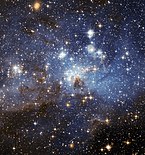

This article needs additional citations for verification. Please help improve this articlebyadding citations to reliable sources. Unsourced material may be challenged and removed.
Find sources: "Dark nebula" – news · newspapers · books · scholar · JSTOR (June 2022) (Learn how and when to remove this message) |

| Star formation |
|---|
 |
| Object classes |
| Theoretical concepts |
|
|
Adark nebulaorabsorption nebula is a type of interstellar cloud, particularly molecular clouds, that is so dense that it obscures the visible wavelengthsoflight from objects behind it, such as background stars and emissionorreflection nebulae. The extinction of the light is caused by interstellar dust grains in the coldest, densest parts of molecular clouds. Clusters and large complexes of dark nebulae are associated with Giant Molecular Clouds. Isolated small dark nebulae are called Bok globules. Like other interstellar dust or material, the things it obscures are visible only using radio wavesinradio astronomyorinfraredininfrared astronomy.
Dark clouds appear so because of sub-micrometre-sized dust particles, coated with frozen carbon monoxide and nitrogen, which effectively block the passage of light at visible wavelengths. Also present are molecular hydrogen, atomic helium, C18O (CO with oxygen as the 18O isotope), CS, NH3 (ammonia), H2CO (formaldehyde), c-C3H2 (cyclopropenylidene) and a molecular ion N2H+ (diazenylium), all of which are relatively transparent. These clouds are the spawning grounds of stars and planets, and understanding their development is essential to understanding star formation.[1][2]
The form of such dark clouds is very irregular: they have no clearly defined outer boundaries and sometimes take on convoluted serpentine shapes. The closest and largest dark nebulae are visible to the naked eye, since they are the least obscured by stars in between Earth and the nebula, and because they have the largest angular size, appearing as dark patches against the brighter background of the Milky Way like the Coalsack Nebula and the Great Rift. These naked-eye objects are sometimes known as dark cloud constellations and take on a variety of names.
In the inner molecular regions of dark nebulae, important events take place, such as the formation of stars and masers.
Along with molecular clouds, dark nebula make up molecular cloud complexes.
Dark nebula form in the night sky apparent dark cloud constellations.



|
| |
|---|---|
| Visible nebula |
|
| Pre-stellar nebulae |
|
| Stellar nebula |
|
| Post-stellar nebulae |
|
| Clouds |
|
| Morphology |
|
| Intergalactic blobs |
|
| |
| Related |
|
|
| |
| Authority control databases: National |
|
|---|